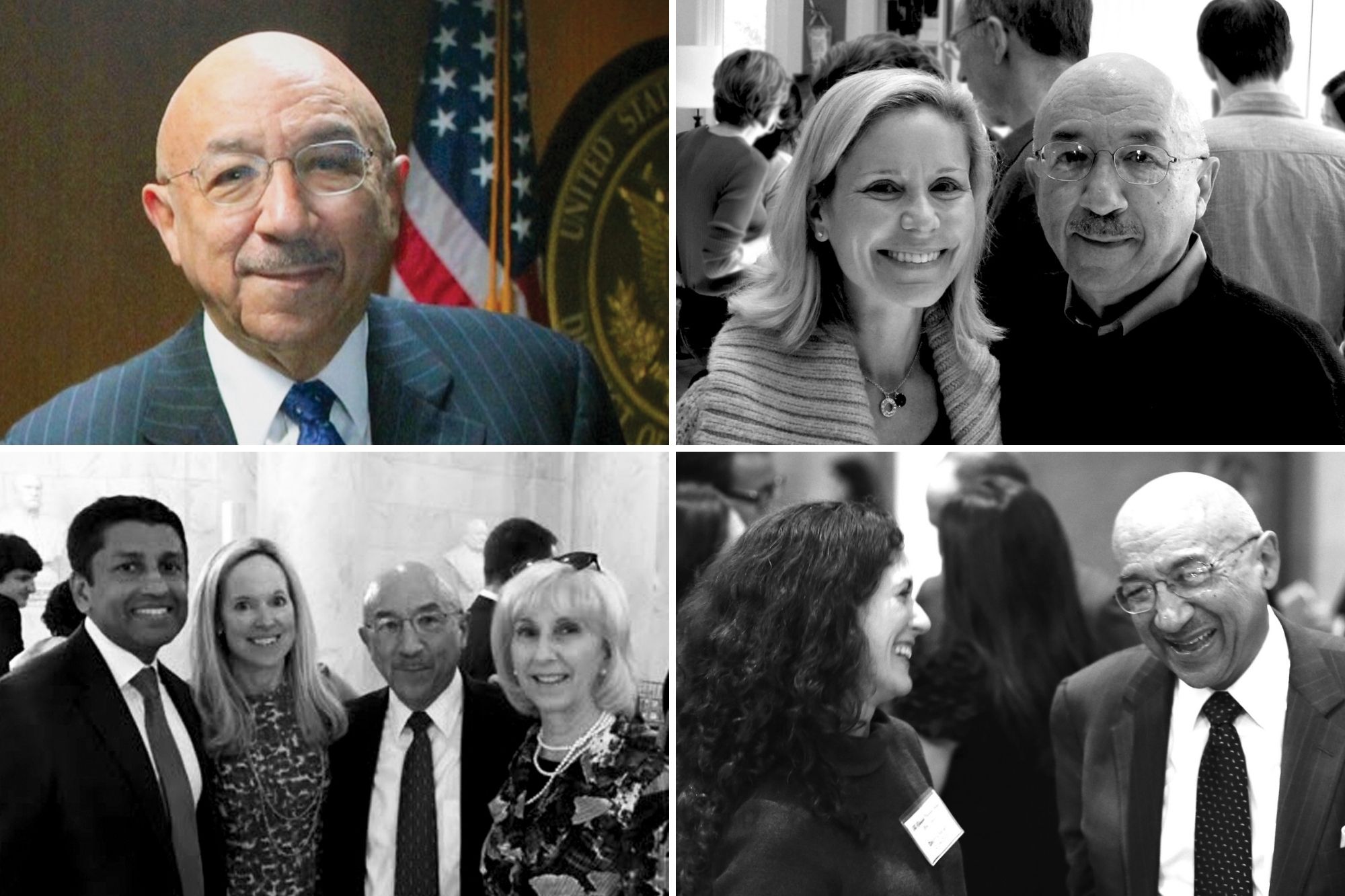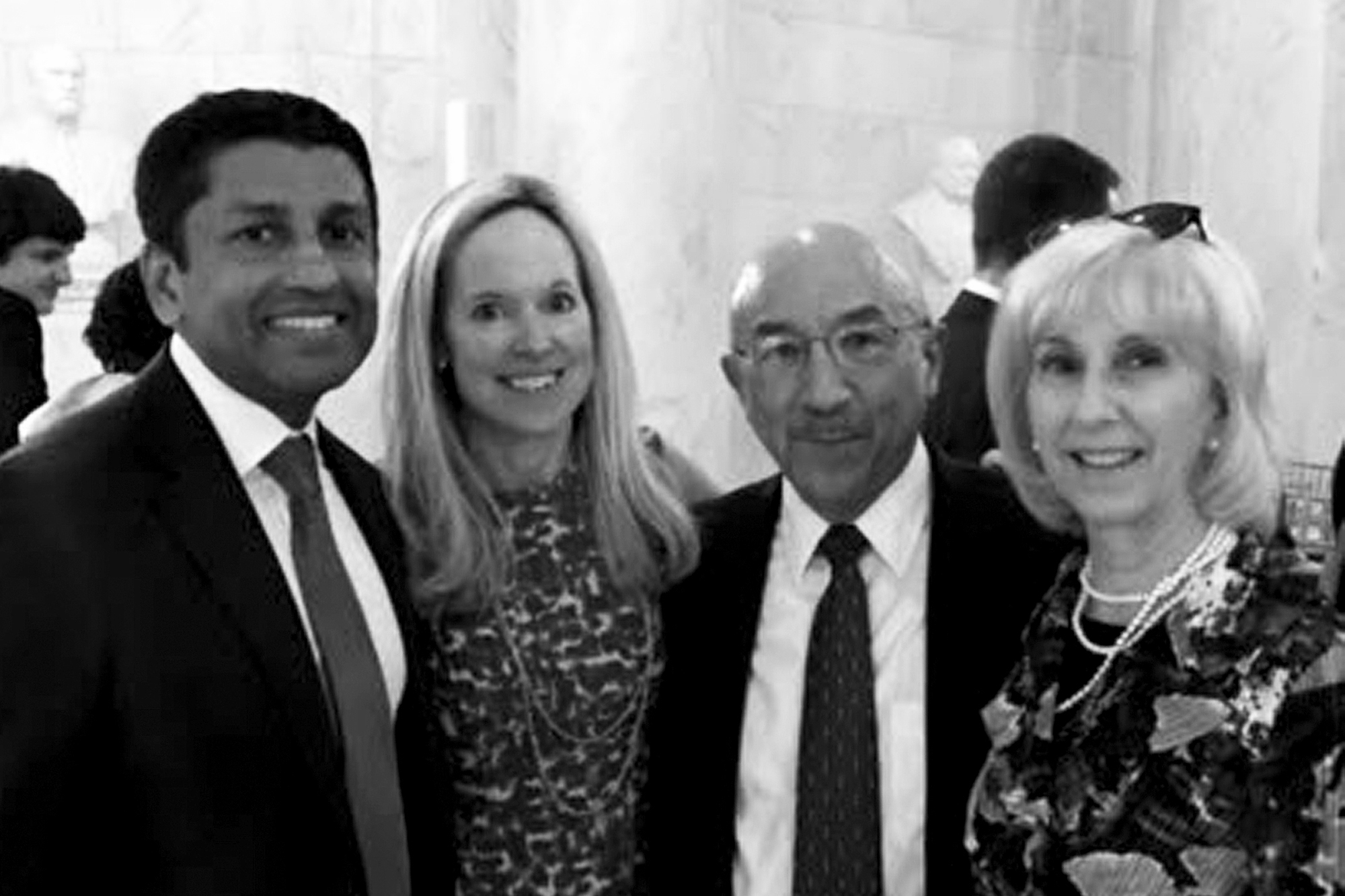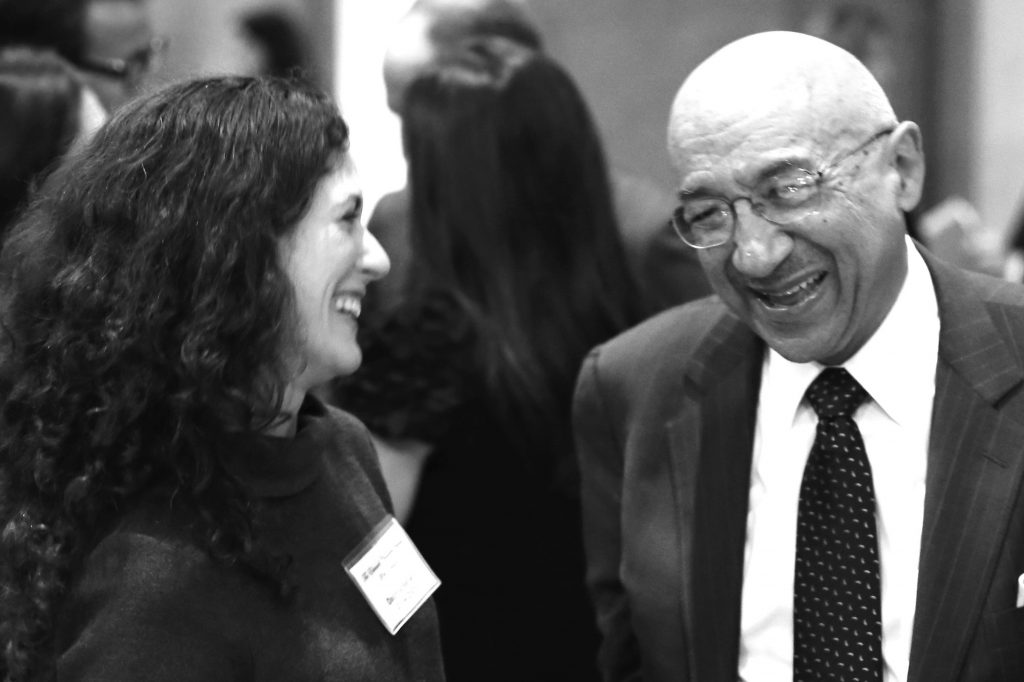A Model of Collegiality: Judge Harry T. Edwards
by Pamela Harris, Daphna Renan and Sri Srinivasan
Vol. 105 No. 1 (2021) | The Courts Held | Download PDF Version of Article

Chief Judge Srinivasan (left) with Lisa Frelinghuysen, Judge Edwards, and Pamela Carrington-Edwards
One of Judge Harry Edwards’s successors as chief judge of the D.C. Circuit has called Judge Edwards the “Great Chief.” That is a fitting appellation. While Judge Edwards could serve as chief for no more than the statutorily prescribed period of seven years — not the 34 years served by the original “Great Chief,” Chief Justice Marshall — Judge Edwards’s tenure as chief judge is rightly considered a markedly significant and successful one. His close friend and former colleague on the D.C. Circuit, Justice Ruth Bader Ginsburg, said that Chief Judge Edwards “transformed the court into a model of collegiality and efficiency” and “steer[ed] the court on a course of caring collegiality.” I’m particularly grateful for that model, and am a direct beneficiary of it, as a member of the court.
The ledger of Judge Edwards’s accomplishments as chief judge runs exceedingly long. Among other initiatives, he directed efforts to automate the court’s processing of matters in fundamental ways, significantly improving the court’s efficiency — an especially challenging endeavor given the well-earned reputation of judges as often more tech-phobic than tech-savvy. He oversaw the design of a substantial expansion of the court’s physical plant, including the incorporation of new common areas and lunch spaces, enhancing the ability of judges and court personnel to gather and interact. He organized a lunchtime speaker series for the judges, initiated a tradition of annual dinners, and treated judges with handpicked gifts on their birthdays. In short, he played the roles of architect, social chair, personal shopper, and IT consultant, all to great effect.
All of those measures were of a piece with, and were in service of, the broader object of promoting collegiality, which could be considered Judge Edwards’s organizing principle of leadership. The fruits of that push to collegiality were nowhere manifested more tangibly than in the court’s consideration of United States v. Microsoft, 253 F.3d 34 (D.C. Cir. 2001) (en banc). The Microsoft decision issued in the last month of Judge Edwards’s time as chief judge and marked a fitting culmination of his tenure. The case was extraordinarily complex, with a record containing tens of thousands of pages and oral arguments spanning multiple days. As an indication of the case’s significance, the court elected to hear it en banc at the outset, an exceedingly rare occurrence. The dispute was highly visible and hotly contested, engendering predictions of a divided and perhaps splintered disposition. Those predictions proved decidedly wrong. Under Judge Edwards’s stewardship, the court issued a unanimous, 125-page opinion, with every judge drafting a portion of the opinion and no judge writing separately. Judges on the court at the time have described their pride in delivering a unanimous decision under — and in many ways as a credit to — Judge Edwards’s leadership.
The Microsoft decision was unsigned, signifying a court acting as a collective institution rather than an assemblage of individuals. Judges, though, are independent actors, often proudly so, and a chief judge has virtually no formal authority over her or his colleagues. Instead, a chief judge’s authority, such as it is, rests almost entirely on having the trust of one’s colleagues, and hence on earning a faith that one is acting with fairness, with integrity, and with the broader interests of the institution firmly in mind. That kind of trust is gained over time by the character of one’s actions. Judge Edwards, by all accounts, had that trust in abundance in his time as chief judge.
Judge Edwards evidently earned the confidence and admiration of his peers from an early age. This is a person, after all, who served as his class president for each of his four years in high school. It is not at all the case, though, that he was openly embraced and willingly accepted into any institution of which he was a part. Hardly so. Rather, Judge Edwards has spoken of his experiences as an African American contending with racial bias while growing up and when coming of age in the legal profession.
In high school, a young Harry Edwards was told by his guidance counselor that he was not “suited” to attend Cornell because of his race. He applied and went anyway. Fraternity rush took place in his first days at Cornell, but he received no invitations to join a fraternity at that time because none of the participating fraternities accepted Black students. The entire time Judge Edwards attended Cornell, there were no more than ten African American students on campus. While he excelled there academically, he has described the social experience as a “nightmare.”
When he then attended the University of Michigan Law School, he was the sole African American student in his class. Once again, he performed superbly as a student. A later dean of the law school, as recounted by Justice Ginsburg, described Judge Edwards as “something of a legend at the school, one of the best all around students we ever had.” Nonetheless, the major law firms with which he interviewed in multiple cities told him that they could not hire him because of his race. It was only due to the intervention of a faculty mentor that one Chicago firm ultimately extended him an offer, which he accepted. He later became the first African American law professor at Michigan Law School, which hired him in part in response to student protests demanding greater diversity on the faculty.
Judge Edwards’s fortitude, persistence, and record of achievement in the face of the bias he encountered have enabled him to become not just a leader in the profession, but a pioneer. He has said the following in reflecting on “the ongoing quest for racial justice”: “As lawyers, we certainly understand the need to be vigilant in continuing to press for racial justice in this country. If we do this while modeling integrity, confidence, resilience, and success, the generations that follow will be better positioned to enjoy the fruits of what this country has to offer.” One would be hard pressed to formulate a more apt description of Judge Edwards’s own life, example, and legacy.
— Sri Srinivasan, chief judge of the U.S. Court of Appeals for the D.C. Circuit

Judge Pamela Harris with Judge Edwards
When I became an appellate judge in 2014, I fully expected that Judge Edwards would be my role model.I had watched Judge Edwards — first as his law clerk, and then as a lawyer and a friend — hold himself to the most exacting standards, meticulously preparing for every case and then turning out fully reasoned and carefully crafted opinions. Everything had to be done perfectly because the stakes were so high: Judge Edwards always kept front and center the real-world impact of his work on people’s lives. That core commitment to getting it right, I thought, would be my takeaway from Judge Edwards.
All of that was true, and I still am working toward the impossibly high bar Judge Edwards has set. But in my new job, I also have come to appreciate another of Judge Edwards’s commitments: his commitment to collegiality in appellate decision-making. Getting it right, it turns out, is not only about the work ethic and the analytic rigor. For Judge Edwards, it also is about the engagement with his colleagues, a collective process in which judges reason their way together to the right answer.
Judge Edwards’s passion for judicial collegiality is well known. When I clerked for him in 1990, the D.C. Circuit was just starting to come out of what was widely thought to be a personally bitter and adversarial period in the court’s history. Restoring a sense of community and collegiality was very important to Judge Edwards, especially when he became chief judge in 1994. Most observers rightly credit Judge Edwards with helping to restore a more cooperative and collegial culture on the D.C. Circuit, and he has gone on to write and speak extensively about the importance of judicial collegiality.
Judge Edwards always makes clear that by “collegiality,” he has in mind something more than friendly and civil relationships among judges. There is overlap, of course; Judge Edwards treasures his friendships with his colleagues and understands that civility in disagreement is a precondition of any healthy collaboration. But when Judge Edwards talks about collegiality, he is describing a very substantive conception of the role of an appellate judge, in which reaching decisions through interaction is central to the job.
Not every judge sees it that way. People who become appellate judges often are used to making decisions on their own and tend to be very confident in their own views. Once on the bench, they may emphasize the purity of their own independent judgments, reaching decisions separately from their colleagues and then considering the matter closed. But Judge Edwards embraces the collective dimension of appellate decision-making: judges listening to and learning from each other, willing to be persuaded and also to persuade, testing their views in the crucible of a lively and productive dialogue.
All of this takes work and energy and a fair bit of magnanimity in our dealings with each other. Disagreement, as Judge Edwards has explained, goes hand-in-hand with collegiality; strong collegial relationships are what allow judges to express their disagreements and individual perspectives rather than suppress them for fear that they will be poorly received. A collegial judge has to be willing to engage, and able to navigate, the inevitable differences of opinion with respect and affection.
Judge Edwards thinks — and I have come to agree — that all of this is worth doing, because we as judges are fallible. We have blind spots and intellectual vulnerabilities, and nobody — no matter how thoughtful and dedicated — can decide every case perfectly. Collegiality helps us get it right when we might not on our own. It gives us the benefit of different points of view and others’ wisdom, and allows us to take full advantage of the diversity of backgrounds and professional expertise on our courts.
At bottom, Judge Edwards’s commitment to collegiality boils down to one thing: the generous conviction that we do our best work together, actively engaging each other in an atmosphere of inclusion and mutual respect. It was a privilege to learn this lesson from him as a law clerk, and I am confident that all who have worked with him have benefitted enormously from his example.
— Pamela Harris, judge on the U.S. Court of Appeals for the Fourth Circuit

Professor Daphna Renan with Judge Edwards
Judge Edwards cares deeply about the human impact of the law, while focusing just as intently on the theory and craft of legal reasoning. Part of what I admire so much about Judge Edwards is his ability to hold both of these commitments at once. He has never lost sight of the significant, wide-ranging and far-reaching impact that the law has on the lives of individuals, groups, and communities. He appreciates, and impresses upon his law clerks, the grave responsibility that comes with implementing — and, in the process, making — law that will have a profound impact on the lived experience of many, and on our shared humanity.
If Judge Edwards appreciates the human responsibility of judging, however, he also is deeply immersed in the theory and craft of judicial decision-making. One thing his law clerks learn quickly is just how important legal writing is to the Judge. Judge Edwards loves a good detective novel. But he does not believe a judicial opinion should read like one. He wants the court’s decisions to be clear from the outset, and well-reasoned at every analytical step. For Judge Edwards, a legal opinion should provide a compelling account of the law, grounded in the facts before the court, but deeply alert to the broader doctrinal implications.
Beyond the craft of judicial writing, Judge Edwards cares about the theory underlying the doctrine. I don’t mean theory in the sense of esoteric puzzles and rudderless abstractions. The Judge, both in his own legal scholarship and in his guidance to current law clerks and former-law-clerks-turned-budding-academics, has been very critical about what he famously termed the “growing disjunction” between academic scholarship and the legal profession. But Judge Edwards is deeply attuned to the ways in which strong legal argumentation depends on a framework for analysis.
Indeed, unsatisfied with how instructors and casebooks handled the federal standards of legal review, and the many interesting problems and important puzzles that they pose for courts, Judge Edwards created his own treatise. What motivated the Judge, who was teaching a class at NYU Law at the time, was frustration that he did not have an adequate source to provide his students on this pivotal aspect of judicial reasoning. Rather than muddle through with the available readings, Judge Edwards took on the project of creating a new way to structure the field. The difficulty of creating a treatise covering the various and complex issues involving standards of review — out of whole cloth — cannot be overstated. But Judge Edwards, together with his friend and collaborator Linda Elliott, created a nuanced and rich framework for a stunning amount of material, which they explicated with enormous clarity, coherence, and depth.
Prompted by some early work on the first edition of this treatise, Judge Edwards and I have had a years-long conversation about statutory interpretation and judicial deference. In these conversations, Judge Edwards will regularly assert that he is uninterested in “theory,” and then proceed to advance nuanced theoretical arguments about the role of the judge in light of different types of legal meaning and different kinds of statutory text. When I teach statutory interpretation and administrative law to my own students, there is no greater influence on my own thinking and instruction. No one’s words echo more loudly in my mind, and I often find myself rereading a passage from his treatise, or looking up an old email exchange, in deciding how to teach a new twist in deference doctrine or a connection between different aspects of how courts review administrative action.
While Judge Edwards has written so impactfully about the judge’s obligations in connection to standards of review, he has written just as powerfully about the human responsibility of lifting others up in the legal profession. For Judge Edwards, strong mentorship is not peripheral to the role of being a leader of the bar, it is central. The Judge has often remarked about the impact that his own mentors have had on his life and professional trajectory. “My mentors . . . were absolutely essential to my professional development and accomplishments,” he has written, “[n]ot only did they provide connections and advocate on my behalf at crucial moments in my young adult life, but, more important, they explained the system to me, nurtured me, and gave me the confidence to take on and complete challenging work.”
Those of us blessed to count Judge Edwards as a mentor would say very much the same. The Judge brings to the role of mentor the singular seriousness, thoughtfulness, and tenacity that he brings to everything else he does. It is not uncommon for Judge Edwards to call you before you have even fully realized that you have a professional or life choice to discuss. He spends countless hours on the phone with former clerks — hours he has somehow found, or made, notwithstanding the many pressures and demands on his time. He will dissect every aspect of a decision with you, sensitive to both the professional and personal commitments that each of us strive to best fulfill. The Judge is also an incomparable champion of his students and former law clerks. If the Judge’s legal opinions and scholarly writings have shaped the law, his fierce advocacy and powerful mentorship of so many have reshaped the legal profession.
— Daphna Renan, professor of law at Harvard Law School

